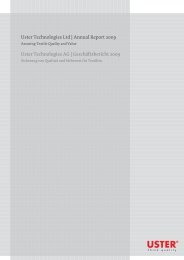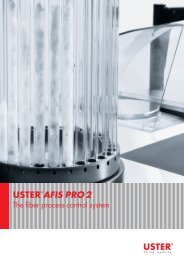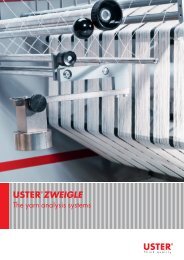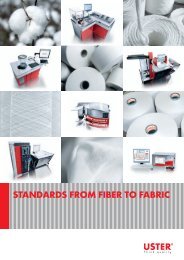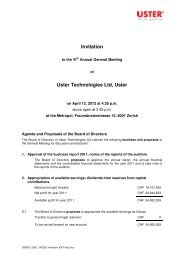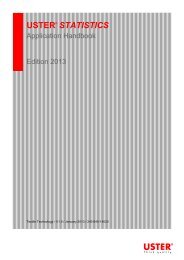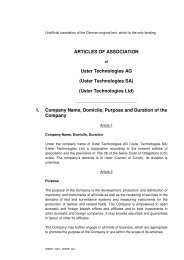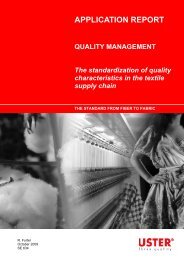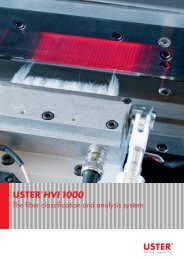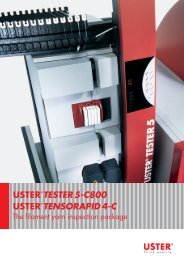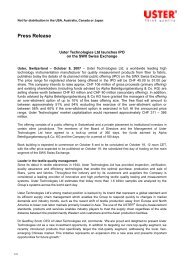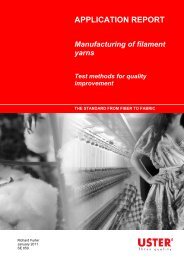Monitoring of the ginning process - Uster Technologies
Monitoring of the ginning process - Uster Technologies
Monitoring of the ginning process - Uster Technologies
You also want an ePaper? Increase the reach of your titles
YUMPU automatically turns print PDFs into web optimized ePapers that Google loves.
®<br />
USTER INTELLIGIN-M<br />
APPLICATION REPORT<br />
<strong>Monitoring</strong> <strong>of</strong> <strong>the</strong> <strong>ginning</strong><br />
<strong>process</strong><br />
THE GIN PROCESS CONTROL SYSTEM<br />
S. Dönmez Kretzschmar, A. Ellison<br />
April 2010<br />
SE 639
THE STANDARD FROM FIBER TO FABRIC<br />
Copyright 2010 by <strong>Uster</strong> <strong>Technologies</strong> AG<br />
All rights reserved. No part <strong>of</strong> this publication may be reproduced, stored in a retrieval<br />
system, translated or transmitted in any form or by any means, electronically,<br />
mechanically, photocopying, recording or o<strong>the</strong>rwise, without <strong>the</strong> prior permission<br />
in writing <strong>of</strong> <strong>the</strong> copyright owner.<br />
veronesi\TT\Schulung_Dokumente\On-Line\INTELLIGIN\SE-439_<strong>Monitoring</strong> <strong>of</strong> <strong>the</strong> <strong>ginning</strong> <strong>process</strong><br />
2 (20) USTER ® PRODUCTS
THE STANDARD FROM FIBER TO FABRIC<br />
Contents<br />
1 Introduction ................................................................................ 5<br />
2 The total quality control <strong>of</strong> <strong>the</strong> <strong>ginning</strong> <strong>process</strong>..................... 5<br />
2.1 What is <strong>the</strong> function <strong>of</strong> a cotton gin ............................................ 5<br />
2.2 Why we should monitor <strong>the</strong> <strong>ginning</strong> <strong>process</strong>.............................. 7<br />
2.3 Benefits and <strong>the</strong> opportunities <strong>of</strong> <strong>the</strong> USTER ® INTELLIGIN ....... 8<br />
3 System Features ...................................................................... 10<br />
3.1 The USTER ® INTELLIGIN –M organization ............................... 11<br />
3.2 The USTER ® INTELLIGIN-M Reports........................................ 14<br />
4 Field Test .................................................................................. 16<br />
5 Conclusion................................................................................ 19<br />
6 Literature................................................................................... 19<br />
USTER ® PRODUCTS 3 (20)
THE STANDARD FROM FIBER TO FABRIC<br />
4 (20) USTER ® PRODUCTS
THE STANDARD FROM FIBER TO FABRIC<br />
1 Introduction<br />
After <strong>the</strong> harvest, a producer wants <strong>the</strong> optimum yield possible and <strong>the</strong><br />
spinner wants <strong>the</strong> highest quality fiber available. The ginner is asked to<br />
make both happen. Cotton <strong>ginning</strong> is an important step in <strong>the</strong> cotton production<br />
sequence. The purpose <strong>of</strong> <strong>the</strong> <strong>ginning</strong> operation is separating <strong>the</strong><br />
cotton seed from <strong>the</strong> lint and removing sticks and coarse trash from <strong>the</strong><br />
input material. Input materials coming from a variety <strong>of</strong> growing areas are<br />
<strong>process</strong>ed toge<strong>the</strong>r and <strong>the</strong> <strong>process</strong> acts as a first blending <strong>of</strong> massive<br />
quantities <strong>of</strong> fibers [1]. The true art <strong>of</strong> <strong>ginning</strong> is knowing when and how to<br />
use a technical advantage. Because not all cottons are <strong>the</strong> same, <strong>the</strong> <strong>ginning</strong><br />
<strong>process</strong> requires constant monitoring based on incoming harvest<br />
qualities, fiber characteristics, picking methods and growing conditions.<br />
The USTER ® INTELLIGIN-M monitors and/or controls <strong>the</strong> <strong>ginning</strong> <strong>process</strong><br />
through a system <strong>of</strong> online sampling stations located throughout <strong>the</strong> gin<br />
from <strong>the</strong> module feeder to <strong>the</strong> bale press. Information on fiber moisture,<br />
trash and color are fed into a main console where s<strong>of</strong>tware analyzes fiber<br />
value for optimum dryer temperature and lint cleaning practices. Optional<br />
bypass valves automatically reroute cotton only through necessary equipment<br />
preserving fiber quality and reducing <strong>process</strong>ing costs. From an easyto-use<br />
console, <strong>the</strong> ginner has a complete picture <strong>of</strong> all variables and can<br />
manually adjust <strong>the</strong> <strong>process</strong> or set perimeters to allow <strong>the</strong> <strong>process</strong> to run<br />
automatically. The USTER ® INTELLIGIN-M provides total quality control <strong>of</strong><br />
<strong>the</strong> <strong>ginning</strong> <strong>process</strong>.<br />
2 The total quality control <strong>of</strong> <strong>the</strong> <strong>ginning</strong> <strong>process</strong><br />
2.1 What is <strong>the</strong> function <strong>of</strong> a cotton gin<br />
The principal function <strong>of</strong> <strong>the</strong> cotton gin is to separate lint from seed. The gin<br />
must also be equipped to remove foreign matter, moisture, and o<strong>the</strong>r contaminants<br />
that significantly reduce <strong>the</strong> value <strong>of</strong> <strong>the</strong> ginned lint.<br />
Gins (Fig. 1) must produce a quality <strong>of</strong> lint that brings <strong>the</strong> owner <strong>of</strong> <strong>the</strong> cotton<br />
maximum value while meeting <strong>the</strong> demands <strong>of</strong> <strong>the</strong> spinner and consumer.<br />
Cotton seed is an important by-product <strong>of</strong> cotton manufacture and<br />
most <strong>of</strong> <strong>the</strong> seed is crushed for oil or used for animal feed. According to <strong>the</strong><br />
yarn producer, cotton seed represents hazard and excessive seed-coat<br />
fragments make <strong>the</strong> spinning <strong>process</strong> more difficult.<br />
USTER ® PRODUCTS 5 (20)
THE STANDARD FROM FIBER TO FABRIC<br />
Fig. 1<br />
Gin<br />
On <strong>the</strong> o<strong>the</strong>r hand, <strong>the</strong> economics <strong>of</strong> <strong>ginning</strong> are affected by <strong>the</strong> sale <strong>of</strong> byproducts,<br />
and thus <strong>the</strong>y have some effect on <strong>the</strong> cost <strong>of</strong> <strong>the</strong> cotton mill. The<br />
cost <strong>of</strong> <strong>the</strong> cotton in <strong>the</strong> mill represents roughly half <strong>of</strong> <strong>the</strong> yarn cost. Not<br />
only <strong>the</strong> cost but also <strong>the</strong> quality <strong>of</strong> <strong>the</strong> product depends <strong>the</strong> total quality<br />
control <strong>of</strong> <strong>the</strong> <strong>ginning</strong> <strong>process</strong> Therefore <strong>the</strong> yarn producer must have a<br />
strong interest in <strong>the</strong> basic fiber production [1].<br />
Fig. 2<br />
Cotton lint and cotton seed<br />
Cotton Ginning<br />
Transportation to<br />
warehouse<br />
Warehousing / Storage<br />
Transportation<br />
to mill<br />
Preparation in Mill<br />
Fig. 3<br />
Fiber Flow – Field to Sliver<br />
6 (20) USTER ® PRODUCTS
THE STANDARD FROM FIBER TO FABRIC<br />
2.2 Why we should monitor <strong>the</strong> <strong>ginning</strong> <strong>process</strong><br />
We should monitor <strong>the</strong> <strong>ginning</strong> <strong>process</strong> because <strong>the</strong> cotton is a huge variable<br />
with different:<br />
Cotton Varieties<br />
Fiber Characteristics<br />
Picking Methods (Spindle – stripper – hand )<br />
Growing Conditions<br />
Harvest Conditions<br />
Market Changing Requirements<br />
Domestic<br />
Export<br />
Because not all cottons are <strong>the</strong> same, <strong>the</strong> <strong>ginning</strong> <strong>process</strong> requires constant<br />
monitoring based on incoming harvest qualities, fiber characteristics,<br />
picking methods and growing conditions. The USTER ® INTELLIGIN-M<br />
monitors and/or controls <strong>the</strong> <strong>ginning</strong> <strong>process</strong> through a system <strong>of</strong> online<br />
sampling stations located throughout <strong>the</strong> gin from <strong>the</strong> module feeder to <strong>the</strong><br />
bale press. Information on fiber moisture, trash and color are fed into a<br />
main console where s<strong>of</strong>tware analyzes fiber value for optimum dryer temperature<br />
and lint cleaning practices. The USTER ® INTELLIGIN provides<br />
total quality control <strong>of</strong> <strong>the</strong> <strong>ginning</strong> <strong>process</strong> (Fig. 4). Thus <strong>the</strong> ginner has a<br />
complete picture <strong>of</strong> all variables and can manually adjust <strong>the</strong> <strong>process</strong> or set<br />
perimeters to allow <strong>the</strong> <strong>process</strong> to run automatically.<br />
High Moisture – Max Drying<br />
Intelligin Zone<br />
Maximum<br />
Advantage<br />
High Trash<br />
Domestic<br />
Export<br />
Low Trash<br />
Intelligin Minimum<br />
Advantage<br />
Low Moisture – Min Drying<br />
Fig. 4<br />
Process Control Decisions<br />
USTER ® PRODUCTS 7 (20)
THE STANDARD FROM FIBER TO FABRIC<br />
2.3 Benefits and <strong>the</strong> opportunities <strong>of</strong> <strong>the</strong> USTER ®<br />
INTELLIGIN<br />
In Table 1 and in <strong>the</strong> following figures (Fig. 5 to Fig. 9) we can see <strong>the</strong><br />
measurement and control opportunities and benefits <strong>of</strong> <strong>the</strong> USTER ® IN-<br />
TELLIGIN-M during <strong>the</strong> <strong>ginning</strong> <strong>process</strong>.<br />
Ginning<br />
Process<br />
Sections <strong>of</strong> Gin<br />
Measurement<br />
Opportunities<br />
Control<br />
Opportunites<br />
Benefits<br />
Figure<br />
Seed Cotton<br />
Entry Into<br />
Gin<br />
1. Module Feeder<br />
2. Suction Telescopes<br />
3. Big-J Feed Control<br />
- Incoming Moisture<br />
- Incoming Trash<br />
- Feed Rate Seed<br />
Cotton<br />
- Gin Performance<br />
- Trash Levels –<br />
Cleaning % Efficiency<br />
Fig. 5<br />
Seed Cotton Cleaning<br />
& Drying<br />
4. Vertical Flow Drier<br />
5. Incline Cleaner<br />
6. Stripper Cleaner<br />
7. Stick Machine<br />
8. Tower Drier<br />
9. Incline Cleaner<br />
10. Impact Cleaner<br />
- Temperature for<br />
Drying<br />
- Quantity <strong>of</strong> Pre-<br />
Cleaning Stages<br />
- Maximized Yield<br />
- Gin Performance<br />
- Fiber Quality (Length,<br />
Neps, Trash,<br />
Strength<br />
- Energy Costs<br />
Fig. 6<br />
Ginning –<br />
Separation<br />
<strong>of</strong> Seed and<br />
11. Conveyor Distributor<br />
12. Feeder<br />
13. Gin Stand<br />
- Moisture - Temperature for<br />
Drying<br />
- Optimized Moisture<br />
for Ginning<br />
- Fiber Quality<br />
Fig. 7<br />
Trash Removal From<br />
Lint<br />
14. Centrifugal Cleaner<br />
15. 24-D Tandem Lint<br />
Cleaners<br />
- Trash Level in Lint<br />
- Color<br />
- Moisture<br />
- Quantity <strong>of</strong> Lint<br />
Cleaners<br />
- Quantity Grid Bars<br />
(Louver Control)<br />
- Maximized Yield<br />
- Fiber Quantity – No<br />
Unnecessary Cleaning<br />
- Fiber Quality<br />
- Maximized Value<br />
Based on Market Criteria<br />
Fig. 8<br />
Baling – Final Package<br />
16. Battery Condenser<br />
17. Covered Lint Slide<br />
17. Moisture Addition<br />
18. Belt Feeder<br />
19. Bale Press<br />
20. Bale Tying<br />
21. Bale Bagging and<br />
Conveying<br />
- Trash Final<br />
- Color Final<br />
- Moisture in Lint After<br />
Cleaning<br />
- Moisture in Bale<br />
- Feedback to Prior<br />
Measurements<br />
- Moisture Restoration<br />
- Maximized Yield<br />
- Immediate Knowledge<br />
Grades for<br />
Merchandizing<br />
- Final Color & Trash<br />
Grades for Allocation<br />
& Storage<br />
- Final Moisture Optimized<br />
- Warehousing Efficiencies<br />
Fig. 9<br />
Table 1 The measurement and control opportunities and benefits <strong>of</strong> <strong>the</strong> USTER ® INTELLIGIN -M<br />
8 (20) USTER ® PRODUCTS
THE STANDARD FROM FIBER TO FABRIC<br />
Fig. 5<br />
Seed Cotton Entry Into Gin<br />
Fig. 6<br />
Seed Cotton Cleaning & Drying<br />
Fig. 7<br />
Ginning - Separation <strong>of</strong> Seed<br />
and Lint<br />
Fig. 8<br />
Trash Removal From Lint<br />
Fig. 9<br />
Baling - Final Package<br />
USTER ® PRODUCTS 9 (20)
THE STANDARD FROM FIBER TO FABRIC<br />
3 System Features<br />
The basic USTER ® INTELLIGIN-M system is for monitoring, information,<br />
and database collection purposes only. The system includes one measurement<br />
station at lint flue. The USTER ® INTELLIGIN-M system provides<br />
leaf grade, % trash, color grade, extraneous matter identification, and lint<br />
moisture measurement at lint flue. Reports on machine use, moisture, leaf<br />
and color as well as gas & electricity use on a per bale basis if outputs are<br />
provided.<br />
There are also some additional available options or measurements:<br />
<br />
<br />
<br />
<br />
<br />
Louvered Grid Bar Control<br />
Incoming module moisture<br />
Final Bale moisture<br />
Energy <strong>Monitoring</strong><br />
Machine Efficiency <strong>Monitoring</strong><br />
The “Monitor” system gives gins with hands on management <strong>the</strong> necessary<br />
tools for <strong>process</strong>ing quality cotton. This system will monitor <strong>the</strong> gin <strong>process</strong><br />
from manual changes and adjustments. Ginners can use realtime information<br />
to make decisions for setting dryer temperatures and determining leaf<br />
grades. The “Control” system constantly controls <strong>the</strong> gin to set specifications<br />
without constant manual changes, leaving <strong>the</strong> ginner to focus on labor<br />
and maintenance issues.<br />
Monitor or Control system<br />
Real-time measurement <strong>of</strong> fiber color, trash and moisture<br />
Patented color and trash sensor technology to HVI modules<br />
Reporting s<strong>of</strong>tware for an up-to-<strong>the</strong>-minute data analysis<br />
Control system only<br />
Patented decision making s<strong>of</strong>tware algorithms<br />
Main console with touch screen controls that integrates into current gin<br />
control database<br />
Automatic control <strong>of</strong> dryer temperature for optimum fiber moisture<br />
Automatic control <strong>of</strong> seed cotton and lint cleaner bypass valves<br />
10 (20) USTER ® PRODUCTS
THE STANDARD FROM FIBER TO FABRIC<br />
3.1 The USTER ® INTELLIGIN –M organization<br />
The following diagrams shows us <strong>the</strong> USTER ® INTELLIGIN-M organization<br />
and <strong>the</strong> system layout <strong>of</strong> <strong>the</strong> sampling station and <strong>the</strong> USTER ® INTELLIGIN<br />
host console in <strong>the</strong> gin (Fig. 10 and Fig. 11).<br />
Gin Office<br />
Gin<br />
Internet<br />
Real Time<br />
Display<br />
Real Time<br />
Display<br />
Remote<br />
Service and<br />
Support<br />
Process<br />
Measurements<br />
Reports<br />
Remote<br />
<strong>Monitoring</strong> by<br />
Gin Mgmt<br />
USDA<br />
Information Input<br />
for Calibration<br />
Gin Console<br />
Sampling Station<br />
Fig. 10<br />
The USTER ® INTELLIGIN –<br />
M organization<br />
IntelliGin host console<br />
Sampling Station Fig. 11<br />
System layout in <strong>the</strong> gin<br />
The system has a sampling station and a host console. Positioned just past<br />
<strong>the</strong> lint cleaners, this station gives a final reading <strong>of</strong> fiber moisture, trash<br />
and color to ensure <strong>the</strong> accuracy <strong>of</strong> <strong>the</strong> decisions made before cotton enters<br />
<strong>the</strong> bale press. This information is used to give feedback to ginners so<br />
that <strong>the</strong>y might make adjustments to <strong>the</strong> <strong>ginning</strong> <strong>process</strong> to optimize fiber<br />
qualities, yield and moisture content (Fig. 12 and Fig. 13)<br />
USTER ® PRODUCTS 11 (20)
THE STANDARD FROM FIBER TO FABRIC<br />
Fig. 12<br />
Lint Flue Sampling Station<br />
Fig. 13<br />
Lint Flue Sampling Station<br />
In Fig. 14, we can see <strong>the</strong> sampling station and all sensors such as paddle<br />
sampler, moisture measuring sensor and <strong>the</strong> USTER ® HVI color head.<br />
Paddle Sampler<br />
Moisture Measuring Sensor<br />
HVI Color Head<br />
Fig. 14<br />
Sampling Station<br />
Open, showing all sensors<br />
12 (20) USTER ® PRODUCTS
THE STANDARD FROM FIBER TO FABRIC<br />
The main console gives <strong>the</strong> ginner a complete summary <strong>of</strong> <strong>the</strong> <strong>ginning</strong><br />
<strong>process</strong>. It provides information that is necessary for <strong>the</strong> ginner to make<br />
informed decisions to improve fiber moisture levels, and preserve fiber<br />
properties (Fig. 15).<br />
Fig. 15<br />
Gin Host Console<br />
By using this system, <strong>the</strong> user can make reliable cotton value decisions by<br />
using real time information which is obtained by <strong>the</strong> USTER ® INTELLIGIN –<br />
M.<br />
Classer‘s<br />
Trash<br />
Leaf Grade<br />
Measurement<br />
(% area)<br />
1<br />
THE STANDARD FROM FIBER TO FABRIC<br />
Specification<br />
Measurement<br />
Opportunities<br />
Control<br />
Opportunites<br />
Benefits<br />
Indication <strong>of</strong> bark and<br />
grass<br />
Automatic Bark & Grass<br />
Detection<br />
Quick feedback to producer<br />
Optimized <strong>ginning</strong> decisions<br />
Reduced discounts if<br />
<strong>ginning</strong> procedures will<br />
reduce contamination<br />
Table 2<br />
The measurement and control opportunities and benefits <strong>of</strong> <strong>the</strong> USTER ® INTELLIGIN-M Texas<br />
Fig. 17<br />
Indication <strong>of</strong> Bark and Grass<br />
3.2 The USTER ® INTELLIGIN-M Reports<br />
The USTER ® INTELLIGIN-M gives <strong>the</strong> user easy-to-read graphical reports<br />
and provide summaries and in-depth analysis <strong>of</strong> bale characteristics for<br />
producers (Fig. 18).<br />
Fig. 18<br />
Report<br />
14 (20) USTER ® PRODUCTS
THE STANDARD FROM FIBER TO FABRIC<br />
The trends for <strong>process</strong> improvement are also available for gin administration<br />
(Fig. 19).<br />
Fig. 19<br />
Display <strong>of</strong> <strong>the</strong> USTER ® IN-<br />
TELLIGIN<br />
The reporting package delivers analytical reports that detail every level <strong>of</strong><br />
<strong>the</strong> <strong>ginning</strong> <strong>process</strong>. Reports such as color grade, leaf grade and moisture<br />
provide value to producers, while production and shift reports are essential<br />
to improving gin pr<strong>of</strong>itability.The monitoring <strong>of</strong> <strong>the</strong> final bale moisture enables<br />
<strong>the</strong> ginner to see <strong>the</strong> realtime results <strong>of</strong> <strong>the</strong> <strong>ginning</strong> <strong>process</strong> as it affects<br />
<strong>the</strong> moisture <strong>of</strong> cotton (Fig. 20).<br />
Fig. 20<br />
Graphs <strong>of</strong> <strong>the</strong> bales<br />
USTER ® PRODUCTS 15 (20)
THE STANDARD FROM FIBER TO FABRIC<br />
Moisture <strong>of</strong> cotton is critical when decisions are being made to optimize <strong>the</strong><br />
dryer settings. The final bale moisture sensor also allows <strong>the</strong> ginners to see<br />
<strong>the</strong> results <strong>of</strong> any supplemental moisture restoration system. Research<br />
shows that optimum moisture level in a bale is 7.5%, matching USDA conditions<br />
for classing cotton. Achieving this balance depends on accurate<br />
measurements throughout <strong>the</strong> <strong>ginning</strong> <strong>process</strong> (Fig. 21).<br />
Fig. 21<br />
Actual dryer temperatures<br />
4 Field Test<br />
During a field test, we have taken cotton from <strong>the</strong> same cotton field. The<br />
yield has been made under <strong>the</strong> same conditions and <strong>the</strong> same amount <strong>of</strong><br />
raw material has been <strong>process</strong>es first time by using (active) <strong>the</strong> USTER ®<br />
INTELLIGIN and <strong>the</strong> second time without using (passive) <strong>the</strong> USTER ® IN-<br />
TELLIGIN.<br />
These cotton bales are tested by using <strong>the</strong> USTER ® HVI. When we look at<br />
<strong>the</strong> percentage <strong>of</strong> <strong>the</strong> total measured bales which are ginned with <strong>the</strong><br />
USTER ® INTELLIGIN, <strong>the</strong> fibers shorter than 34 mm are only 1%. The<br />
bales which have fiber lengths <strong>of</strong> 37 mm or more have a percentage <strong>of</strong><br />
70%. On <strong>the</strong> contrary, <strong>the</strong> bales which are ginned without <strong>the</strong> USTER ® IN-<br />
TELLIGIN have generally lower mean length values (Fig. 22).<br />
16 (20) USTER ® PRODUCTS
THE STANDARD FROM FIBER TO FABRIC<br />
80<br />
70<br />
60<br />
Without Intelligin<br />
58<br />
With Intelligin<br />
70<br />
50<br />
40<br />
30<br />
20<br />
24<br />
29<br />
18<br />
10<br />
0<br />
1<br />
< 34 35 - 36 > 37<br />
Fig. 22<br />
USTER ® HVI length values<br />
When we look at <strong>the</strong> percentage <strong>of</strong> <strong>the</strong> total measured bales which are<br />
ginned with <strong>the</strong> USTER ® INTELLIGIN, <strong>the</strong> fibers with a strength value <strong>of</strong> 28<br />
or less are only 24%. The bales which have fiber strength <strong>of</strong> 30 [cN/tex] or<br />
more have a percentage <strong>of</strong> 52%. On <strong>the</strong> contrary, <strong>the</strong> bales which are<br />
ginned without <strong>the</strong> USTER ® INTELLIGIN have generally lower mean<br />
strength values (Fig. 23).<br />
60<br />
50<br />
40<br />
41<br />
Without Intelligin<br />
With Intelligin<br />
34<br />
52<br />
30<br />
24 25 24<br />
20<br />
10<br />
0<br />
< 28 29 > 30<br />
Fig. 23<br />
USTER ® HVI strength<br />
values<br />
In Fig. 24, we can see that <strong>the</strong> bales which are ginned with <strong>the</strong> USTER ®<br />
INTELLIGIN have generally better uniformity values.<br />
USTER ® PRODUCTS 17 (20)
THE STANDARD FROM FIBER TO FABRIC<br />
90<br />
80<br />
70<br />
60<br />
50<br />
40<br />
30<br />
20<br />
10<br />
0<br />
Without Intelligin With Intelligin<br />
77<br />
55<br />
44<br />
14<br />
9<br />
1<br />
77 - 79 80 - 82 83 - 85<br />
Fig. 24<br />
USTER ® HVI uniformity<br />
values<br />
In Fig. 25, we can see <strong>the</strong> quality characteristics <strong>of</strong> <strong>the</strong> cotton fibers. The<br />
mean values <strong>of</strong> neps, <strong>the</strong> upper quartile length (w) and short fiber content<br />
are given. According to <strong>the</strong> USTER ® AFIS values, we can easily see <strong>the</strong><br />
positive effect <strong>of</strong> <strong>the</strong> USTER ® INTELLIGIN on <strong>the</strong> fiber quality (Fig. 25).<br />
350<br />
300<br />
310<br />
Without Intelligin<br />
With Intelligin<br />
250<br />
200<br />
206<br />
150<br />
100<br />
50<br />
30<br />
0<br />
Neps [1/g]<br />
16<br />
Seed Coat Neps<br />
[1/g]<br />
12.4<br />
8.3<br />
1.13 1.21<br />
UQL [mm] SFC [%]<br />
Fig. 25<br />
USTER ® AFIS values<br />
18 (20) USTER ® PRODUCTS
THE STANDARD FROM FIBER TO FABRIC<br />
5 Conclusion<br />
The USTER ® INTELLIGIN -M provides a cotton ginner with critical data,<br />
enabling <strong>the</strong> gin to <strong>process</strong> for weight and grade optimization. Using patented<br />
sensor technology, <strong>the</strong> USTER ® INTELLIGIN-M monitors <strong>the</strong> <strong>ginning</strong><br />
<strong>process</strong> quality through a system <strong>of</strong> online sampling stations. Online measurements<br />
provide information on moisture, color and trash for optimum<br />
<strong>process</strong>ing. The special s<strong>of</strong>tware analyzes <strong>the</strong> fiber quality for optimum<br />
dryer temperature and cleaning practices. Cotton is not over- or underdried<br />
or over- or undercleaned – preserving grade and bale weight. With <strong>the</strong> optional<br />
final bale moisture system, <strong>the</strong> USTER ® INTELLIGIN also ensures<br />
that producers get <strong>the</strong> most value for <strong>the</strong>ir cotton while preserving fiber<br />
quality.<br />
6 Literature<br />
1. Lord, P. R., “Handbook <strong>of</strong> Yarn Production: Technology, Science and<br />
Economics”, Woodhead Publishing Limited, 2005.<br />
USTER ® PRODUCTS 19 (20)
THE STANDARD FROM FIBER TO FABRIC<br />
<strong>Uster</strong> <strong>Technologies</strong> AG<br />
Sonnenbergstrasse 10<br />
CH-8610 <strong>Uster</strong> / Switzerland<br />
Phone +41 43 366 36 36<br />
Fax +41 43 366 36 37<br />
www.uster.com<br />
sales@uster.com<br />
20 (20)<br />
USTER ® PRODUCTS



